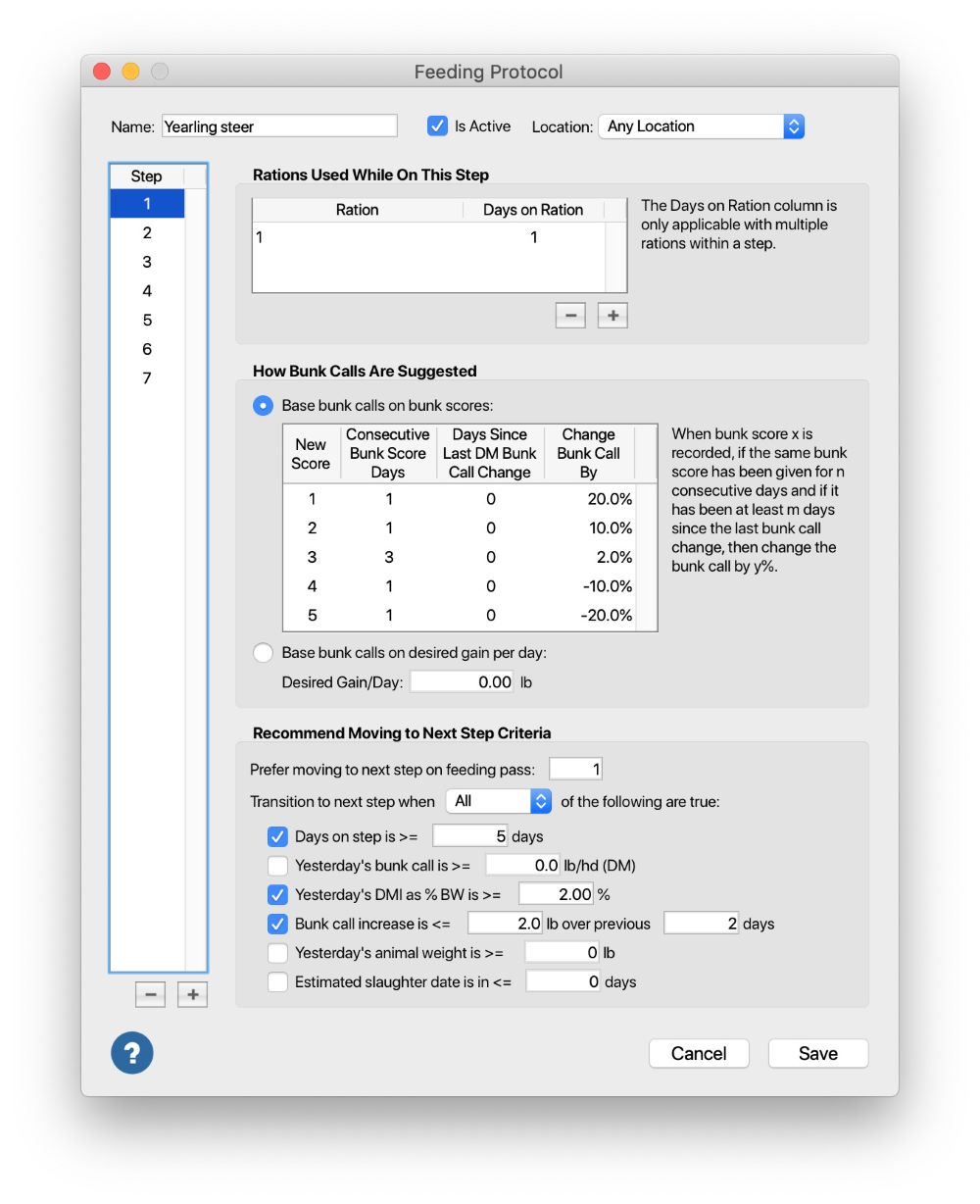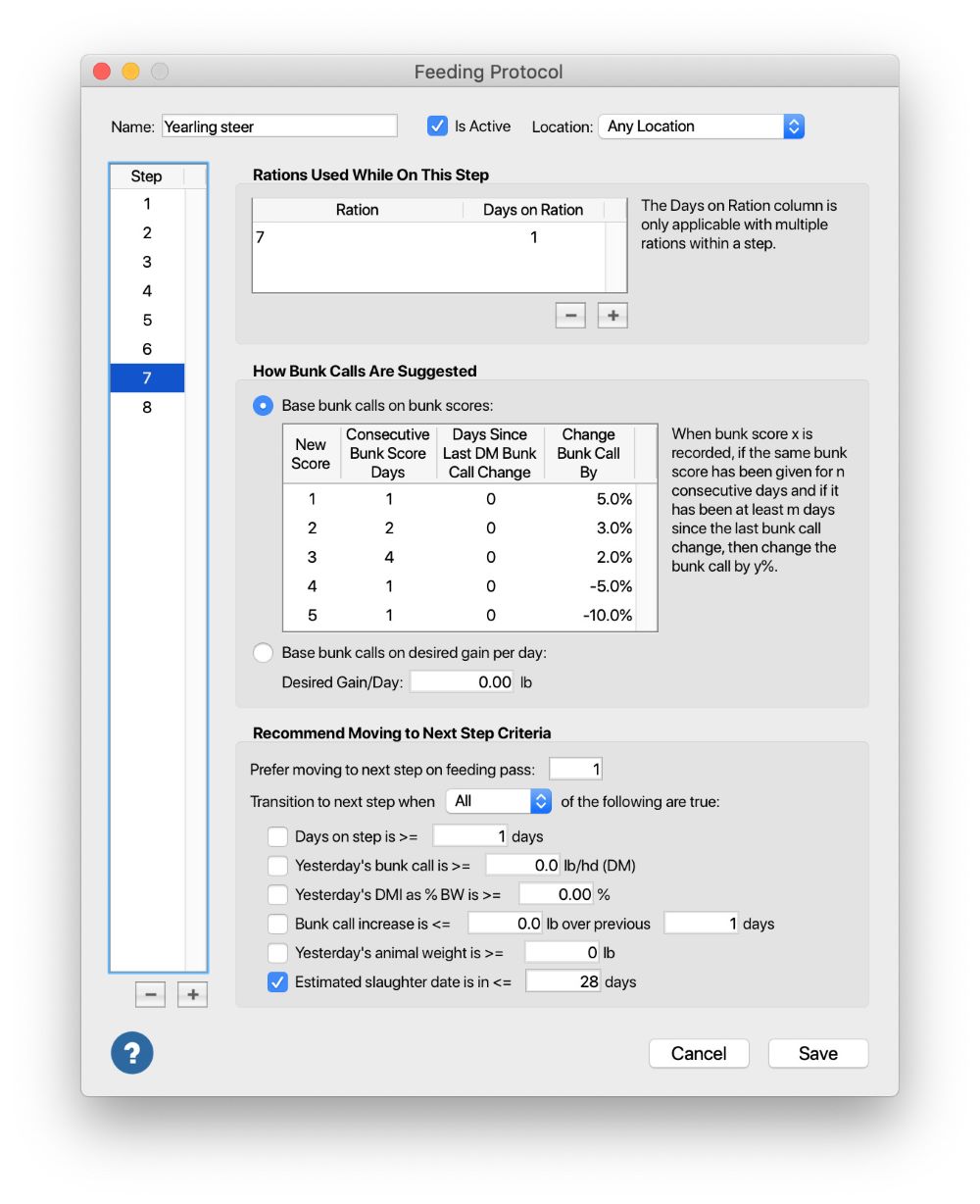Subscribe to our blog to keep up with our products and other industry information.
Most feedlot managers agree that obtaining maximum, stable intakes is a primary objective when finishing cattle. This requires a smooth transition through rations to adapt cattle to high grain diets without being under- or over- reactive when making bunk calls. Ideally, bunk calls should be increased to match appetite without the excess that can contribute to waste and digestive disturbances. With the wide range in appetites of various cattle types combined with a wide range of rations fed, satisfying these constraints requires consideration of several variables.
This article will describe some of the logic and power Fusion has to simplify and automate some fundamentals of bunk management. Fusion has a lot of power to incorporate the many variables that should be considered when making bunk calls or ration changes, so defining feeding protocols will require a bit of thought and time. Hopefully, your nutritionist will help provide input into how the feeding protocols are best defined.
Compared to providing ad lib access to a high forage diet, limit feeding higher energy diets may improve feed efficiency, cost of gain, and likely accuracy in achieving target gains for back grounded cattle. If you are feeding a ration with adequate energy density, you can have Fusion automatically make bunk calls to achieve the desired rate of gain. In the feed protocol window, just enter the desired rate of gain and select “Base Bunk Calls on Desired Rate of Gain”.
There have also been trials that have found improved feed efficiency of finishing diets when feed scarcity stimulates appetite (ie blocking access to feed). There have even been trials demonstrating that feed efficiency can be improved with modest feed restriction of finishing diets. One popular trial (that was never reproduced) found that variation in feed delivery reduced animal performance. Collectively, these observations support a bunk management style that strives for stable intakes, often achieved by frequent slick bunks. Adherents of this style of management believe that the value of improvements in feed efficiency has more value than costs of potential reductions in intakes, ADG or digestive health. The reduced waste, settling, sorting, and shoveling of bunks contributes to the appeal of this type of management.
At the other end of the spectrum, some believe that slick bunks contribute to reduced intake and gains with increased feeding aggression and digestive challenges. This approach makes sense to many producers who strive for maximum intake and gain in all situations, even if it means an occasional increase in feed waste.
Whatever your bunk management style, feeding protocols can be defined in Fusion to achieve your bunk management objectives. The following screen shots provide 2 examples of how a feeding protocol might be defined for 1) the aggressive appetites of newly placed yearlings, and 2) the stable intakes of long fed cattle. This is facilitated through the use of 5 bunk scores that will describe conditions of bunk and cattle while making changes from yesterdays bunk call.
The feeding protocol displayed in the screen shot below is the 1st in a series of steps. As the protocols name implies, this protocol is for yearling steers. It is likely that these cattle will adapt quickly to the feedlot environment resulting in rapidly climbing intakes. As a result, bunk calls must be responsive to appetites without contributing to digestive issues such as overload. In this example, we have defined that a score of 1 will increase the bunk call by 20%. This might mean increasing from 12 to 14.4 lb of dry matter. This is a big change for established cattle, but likely needed for new yearlings. We have defined a score of 2 as increasing the bunk call by 10%. A score of 3 indicates condition of bunks and cattle are ideal. However, in anticipation of climbing intakes, we will increase bunk call by 2% with 3 consecutive days of a score of 3.

Scores greater than 3 indicate there was feed remaining so we have specified that scores 4 and 5 will result in a 10% and 20% reduction in the bunk call. In this example, a score of 2 could follow the score of 4 when excess feed is cleaned up. This would put intakes slightly below the point that resulted in feed accumulation. Cut hard and recover fast is a good motto when cleaning up excess feed.
For each score, we also have an opportunity to define if/when a change in bunk call will occur. For example, we can specify to make a change only if a specified number of days has occurred since the last change in bunk call. This feature will help stabilize intakes by reducing frequency of changes. Similarly, you can specify that a bunk score must be repeated for a specified number of days before there is a change in the bunk call.
We can also define when ration changes should occur. For step 1, we have defined that we will introduce the new step (ration 2) on the 1st pass. Although we can dilute the impact of a ration change by introducing it on the 2nd delivery, Fusion will guide you to deliver exactly what is required for each pass if 2 passes are defined. This results in more part loads and reduced efficiency of truck use. This is why we have chosen to define just 1 pass in this example. We can still introduce the new ration on the 2nd delivery, even if only 1 pass is defined. We have specified that we will move to step 2 after cattle have been on step 1 for 5 days and dry matter intakes are greater than 2% of body weight. This will ensure that cattle are well adapted to this level of grain and intakes will have started to stabilize before a ration change occurs. We can also specify to not go to next step until yesterday’s bunk call is greater than a defined quantity, or % of body weight. In our protocol for step 1, we have specified to advance to the next step only when increases in bunk calls are no more than 2 pounds over previous 2 days.
We could also have specified to advance to the next step if cattle are greater than a specified weight. This constraint may be most useful to trigger a move off of a back grounding diet.
As well, we can specify to advance to the next step only if estimated slaughter date is less than a specified number of days. This feature would be good to trigger a move to Optaflexx or off of a ration that may have a long withdrawal.
The first step provided an example of where we might want to use generous, frequent increases to keep up with the rapidly climbing intake of newly placed yearlings. Step 7 will provide an example of long fed cattle with a focus on maintaining maximum, stable intakes. As can be seen in the screen shot below, we have defined that a score of 1 and 2 will only increase the bunk call by 5 and 3% respectively. It will take 2 consecutive scores of 2 to trigger this increase. A score of 3 will not result in a change unless there has been 4 consecutive days of this bunk score, at which time an increase of 2% will occur. Because heavy, long fed cattle don’t show their appetites like new cattle do, it can be a good practice to offer a bit more feed to cattle that have had “ideal” bunks (score of 3) for several days in a row. This too can help stabilize intakes while ensuring cattle are offered all they can eat.

Scores of 4 and 5 will reduce the bunk call by 5 and 10%. The protocol indicates we will stay on this step until we are within 28 days of harvesting the cattle at which time we will advance to step 8 which is an Optaflexx diet.
Fusion now offers lots of power and flexibility to design a feeding protocol that will simplify and possibly improve your bunk management, especially for new employees.